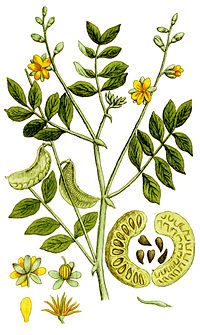
Photo from wikipedia
In the legume genus Senna, series Aphyllae includes seven species of leafless shrubs and subshrubs from arid, semiarid and xerophilous areas of three different biogeographic subregions in southern South America.… Click to show full abstract
In the legume genus Senna, series Aphyllae includes seven species of leafless shrubs and subshrubs from arid, semiarid and xerophilous areas of three different biogeographic subregions in southern South America. In this study, we investigated the evolutionary history of Aphyllae in a molecular phylogenetic framework. We reconstructed phylogenetic relationships among Aphyllae species based on DNA sequence data of four plastid (rpS16, rpL16,matK, trnL-F) and one nuclear (ITS) region from 23 accessions, analyzed with parsimony, Bayesian and maximum likelihood methods. We inferred the evolutionary and biogeographic history estimating divergence times and reconstructing ancestral character states and ancestral areas of distribution. Series Aphyllae was found to be monophyletic, and the taxa formed two main clades: Clade A gathering S. aphylla var. aphylla, S. crassiramea, S. rigidicaulis and S. spiniflora; and Clade B grouping S. acanthoclada, S. aphylla var. divaricata, S. aphylla var. pendula and S. pachyrrhiza. The morphologically complex S. aphylla appears thus polyphyletic. Molecular dating and ancestral area reconstructions suggest that the Aphyllae clade started to diversify in the South American Transition Zone in the Late Pliocene. Based on these results, we hypothesize that this diversification occurred during the last period of Andean uplift with the aridification in South America. The ancestral character state reconstructions suggest that, in addition to the loss of leaves in adult plants, series Aphyllae evolved various morphological features, such as fastigiate, thickened or decumbent–subdecumbent branches during the colonization and establishment in different arid and semiarid lands in South America.
Journal Title: Plant Systematics and Evolution
Year Published: 2017
Link to full text (if available)
Share on Social Media: Sign Up to like & get
recommendations!